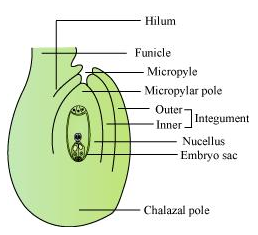With a neat, labelled diagram, describe the parts of a typical angiosperm ovule.
An ovule is a female megasporangium where the formation of megaspores takes place.

The various parts of an ovule are –
(1) Funiculus – It is a stalk-like structure which represents the point of attachment of the ovule to the placenta of the ovary.
(2) Hilum – It is the point where the body of the ovule is attached to the funiculus.
(3) Integuments –They are the outer layers surrounding the ovule that provide protection to the developing embryo.
(4) Micropyle – It is a narrow pore formed by the projection of integuments. It marks the point where the pollen tube enters the ovule at the time of fertilization.
(5) Nucellus – It is a mass of the parenchymatous tissue surrounded by the integuments from the outside. The nucellus provides nutrition to the developing embryo. The embryo sac is located inside the nucellus.
(6) Chalazal – It is the based swollen part of the nucellus from where the integuments originate.
Click here to get exam-ready with eSaral
For making your preparation journey smoother of JEE, NEET and Class 8 to 10, grab our app now.
